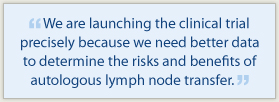Although incidence data vary widely, breast cancer–related lymphedema may affect as many as 54% of the 2.3 million survivors of breast cancer in the United States. The condition is often disabling and can result in both long-term devastating physical consequences for survivors, including the loss of strength and functional limitation of the affected arm, as well psychosocial consequences, such as poor body image and loss of self-esteem.
 While the current standard of care for breast cancer–related lymphedema is complete decongestive therapy—which only slows the progression of disease but does not reverse it—more effective treatments have been elusive. Now, a surgical procedure pioneered by French surgeon Corinne Becker, MD, called autologous lymph node transfer, is being studied in the United States as a potential long-term remedy—and possible cure—for lymphedema sufferers.
While the current standard of care for breast cancer–related lymphedema is complete decongestive therapy—which only slows the progression of disease but does not reverse it—more effective treatments have been elusive. Now, a surgical procedure pioneered by French surgeon Corinne Becker, MD, called autologous lymph node transfer, is being studied in the United States as a potential long-term remedy—and possible cure—for lymphedema sufferers.
The procedure involves taking superficial lymph nodes from a patient’s groin and transplanting them to her axilla to replace the ones removed or damaged during breast cancer treatment. Although the operation has been used in France for 20 years as a treatment for lymphedema, the surgery is rare in the United States, and few hospitals offer it.
To test the effectiveness and potential side effects of lymph node transfer in patients suffering from breast cancer–related lymphedema, Constance M. Chen, MD, MPH, a reconstructive plastic surgeon in New York who specializes in microsurgical breast reconstruction for patients with cancer, has just launched the first double-blind randomized controlled clinical trial of the procedure. Recruitment is taking place at the New York Center for Advancement of Breast Reconstruction, part of the New York Eye and Ear Infirmary.
The ASCO Post talked with Dr. Chen about the benefits and risks of the procedure and the launch of her clinical study.
How the Procedure Is Done
Explain how the autologous lymph node transfer is performed.
Dr. Corinne Becker has done 4,000 lymph node transfers in the treatment of both upper- and lower-extremity lymphedema over the last 20 years in Paris. My clinical trial is for patients with breast cancer who have undergone mastectomy and are suffering from chronic recalcitrant upper-extremity lymphedema. Autologous lymph node transfer is performed by harvesting an average of three superficial inguinal lymph nodes from the groin region on a vascular pedicle, and then transferring the nodes using microsurgery into the axilla of the affected arm.
The first step in this procedure is preparing the axillary recipient site. The axilla in an arm affected by lymphedema is typically scarred and has an extremely hollow appearance because the axillary skin is stuck to the dome of the axilla. This axillary scar tissue needs to be dissected and released, because the scar tissue is blocking the lymphatic channels and preventing lymphatic flow.
After scar release, the second step is microsurgical transfer of healthy, vascularized tissue containing lymph nodes. Without transfer of healthy tissue into the freed-up axillary space, it is hypothesized that the skin would just scar back down to the base of the wound. Bringing in living tissue that comes with its own blood supply creates a healthy environment for the transferred lymph nodes to take up lymphatic flow.
Success Rate and Risks
How successful is lymph node transfer?
According to Dr. Becker’s data, 40% of her patients had complete resolution to lymphedema, meaning their affected arm looked and felt normal without using compression garments. About 28% of her patients had greater than a 50% reduction of arm volume, 28% had less than 50% of arm volume, and 2% had no resolution.
What are the risks?
The most worrisome risk is lower-extremity lymphedema. While Dr. Becker claims that this is not a significant risk in her patients, it seems reasonable that if a patient can develop upper-extremity lymphedema from a sentinel node biopsy then she could also develop lower-extremity lymphedema from the removal of even one lymph node from the groin.
 The more common risk is a postoperative seroma from the groin donor site. Drains and a bolster dressing need to be used in the groin postoperatively to avoid this complication. Finally, there is always the risk that after lymph node transfer there will not be improvement in arm lymphedema. Indeed, we are launching the clinical trial precisely because we need better data to determine the risks and benefits of autologous lymph node transfer.
The more common risk is a postoperative seroma from the groin donor site. Drains and a bolster dressing need to be used in the groin postoperatively to avoid this complication. Finally, there is always the risk that after lymph node transfer there will not be improvement in arm lymphedema. Indeed, we are launching the clinical trial precisely because we need better data to determine the risks and benefits of autologous lymph node transfer.
The procedure seems to show promise as a potential solution to reverse and even cure the long-term effects of chronic recalcitrant lymphedema. More data are needed, however, to make a definitive statement about outcomes. We are currently recruiting patients who suffer from chronic upper-extremity lymphedema following a mastectomy with either no breast reconstruction or implant-based breast reconstruction and who have failed a complete course of complex decongestive therapy. In order to test the hypothesis that autologous lymph node transfer improves upper-extremity lymphedema, we plan to enroll 88 women over a 5-year period. Potential candidates or physicians interested in learning more about this study can either contact me (212-792-6378) or my co-investigator, Mei Fu, PhD, RN, at NYU Cancer Center (212-998-5314). ■
Disclosure: Dr. Chen reported no potential conflicts of interest.

